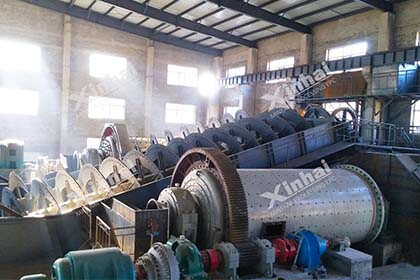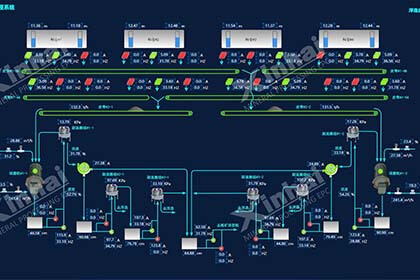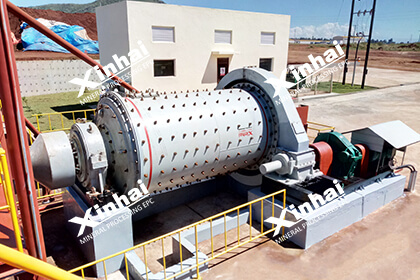Common Grinding Machines Characteristics and Application
 Essow
Essow
 Nov 13, 2020
Nov 13, 2020
 1325
1325
If you want to know more details about equipment, solutions, etc, please click the button below for free consultation, or leave your requirements!
.jpg)
Grinding equipment is one of the main equipments of the concentrator. Generally, the appropriate type of grinding equipment should be selected according to the nature of the ore, the particle size of the product, the processing capacity and other factors.
At present, the commonly used grinding equipment in concentrators mainly include rod mills, grid type ball mills, overflow type ball mills, autogenous mill and gravel mills.
This article will introduce the characteristics and application scope of these 5 types of grinding equipment in details.
01 Rod Mill
BackThe grinding medium of the rod mill is grinding rods. The length of the grinding rod should not exceed 7 meters, because if the rod is too long, it is easy to cause entanglement. Therefore, the rods in the rod mill are usually not too long. The rod diameter is 75 to 150 mm.
(1) Advantages
It has a certain selective grinding effect, the product size is relatively uniform, and there are few over-grinded particles
Compared with the ball mill, rod mill can accept a larger feeding particle size (the upper limit of the feeding particle size is generally 15~25mm)
High production capacity under rough grinding conditions
(2) Disadvantage
Need to stop when adding rods, and the operation efficiency is lower than ball mill
Low output during fine grinding
(3) Application
Rod mill is suitable for rough grinding, the upper limit of product size is generally 1~3mm. It is generally used in the first stage of two-stage (or three-stage) grinding operation, and can also be used in the grinding operation of brittle ores such as tungsten and tin.
02 Grid Type Ball Mill
BackThe grinding medium of the grid type ball mill is steel balls. There is a grid liner installed on the discharge side, and there are many discharge holes on the grid.
The ground pulp passes through the grid liner and is raised to a level higher than the discharge port through the fan-shaped chamber leading to the discharge port, so that the pulp can be discharged from the mill.
(1) Advantages
There is a grid plate at the discharge end, the discharge liquid level is low, the product can be discharged in time, and the phenomenon of over-grinding is relatively light
The processing capacity is higher, 10%~15% higher than the overflow ball mill of the same specification.
(2) Disadvantages
Large ball loading amount, requires high shaft power and heavy equipment weight.
The equipment structure is more complicated and the maintenance is hard.
(3) Application
The upper limit of the product particle size of the grid type ball mill is generally 0.2~0.3mm, so the grid type ball mill is often used in the first stage of grinding.
03 Overflow Type Ball Mill
BackThe grinding medium of the overflow ball mill is also steel balls, and its structure is basically the same as that of the grid type ball mill, except that there is no discharge grid in the cylinder body. The discharge of the overflow ball mill is achieved when the pulp itself higher than the bottom edge of the hollow journal bushing and overflow.
(1) Advantages
The overflow type ball mill adopts an integral frame structure, which is convenient for civil construction and equipment installation.
The internal liner of the overflow ball mill is corrugated type, which makes the liner have a greater lifting force on the steel ball during the rotation process, which can make the steel balls reach a higher height, and the impact caused by falling is greater, making the grinding effect better.
The transmission of the overflow type ball mill adopts large double-row spherical roller bearings instead of sliding bearings, the friction is greatly reduced during the rotation, and it is easy to start, making the motor energy saving by 20-30%.
(2) Disadvantage
The processing capacity is smaller than that of the grid type ball mill of the same specification, and it is easy to reach over-grinding state.
(3) Application
The overflow type ball mill is generally used for grinding operations in the second and third stages (or middlings regrinding), and it can also be used in grinding operations in the first stage.
When the diameter of the mill is greater than 3.6m, the overflow ball mill is often used in the first section of the mine.
Because such large-size mills generally form a closed circuit with hydrocyclones (no spiral classifiers with corresponding specifications are matched), the use of overflow ball mills can reduce the content of coarse particles in the mill discharge, thereby reducing the wear of the hydrocyclone.
04 Autogenous Mill
BackThe autogenous mill does not need steel balls or steel bars to participate in the grinding, and only relies on the mineral itself as the medium. According to the different grinding process methods, the autogenous mill can be divided into two types: dry and wet. At present, the wet autogenous mill is widely used in the concentrator.
(1) Advantages
The feed size is large (the maximum feed size is generally 200~350mm), so it can replace medium and fine crushing and coarse grinding operations, reduce production links and dust pollution (referring to wet autogenous grinding), simplify the composition of the workshop, and reduce the occupation of the concentrator area.
It has a certain selective grinding effect, the product size is relatively uniform, and there are few over-grinded particles.
No or less consumption of grinding medium.
The use of wet autogenous mill for viscous ore with more mud and water can avoid the clogging of crushing, screening and other operations in the conventional process.
(2) Disadvantages
Under normal circumstances, power consumption is higher than conventional grinding.
The equipment operation rate is slightly lower than that of the ball mill
It is sensitive to ore feed size and grindability, production fluctuates easily and operation is more complicated
(3) Application
Due to dust pollution and wind system wear, dry autogenous mill is generally only used in arid and water-deficient areas or under conditions where dry separation is necessary.
05 Gravel Mill
BackThe gravel mill is one of the ancient grinding equipments. From the structure, there is no difference between the gravel mill and the ball mill, except that gravel or pebbles are used as the grinding medium.
(1) Advantages
No metal medium is used, thus reducing steel consumption and making production cost lower.
It can reduce the pollution of iron to the beneficiation process and improve the separation effect in concentrators for rare metal ores and non-metallic minerals.
(2) Disadvantage
Since the specific gravity of the medium used is lighter than that of the steel ball, the output per unit volume is also low
(3) Application
This machine is mainly used for grinding ore products that are afraid of being polluted by iron. It is mainly used in gold and silver ore concentrators.
06 To Wrap Up
BackThe above are the characteristics and application of rod mills, grid type ball mills, overflow type ball mills, autogenous mills and gravel mills. In actual production, we can choose the appropriate type of grinding equipment according to the actual situation.
If you have opinions on the above content, or want to buy grinding equipment, please consult the online customer service of the website or leave a message, we will contact you as soon as possible!
 +86 18716000713
+86 18716000713 xlyin@xinhaimining.net
xlyin@xinhaimining.net




 Message
Message Chat Now
Chat Now

















